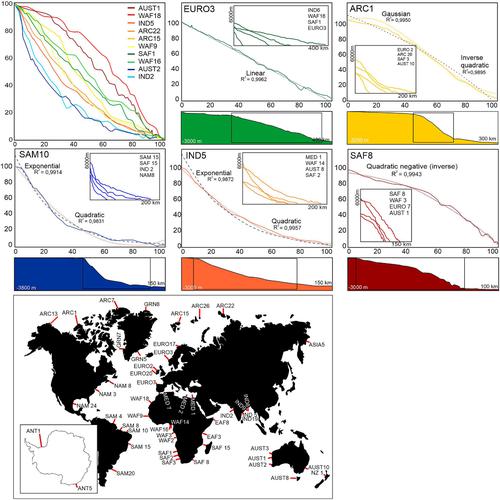当前位置:
X-MOL 学术
›
Basin Res.
›
论文详情
Our official English website, www.x-mol.net, welcomes your
feedback! (Note: you will need to create a separate account there.)
The fourth slope: A fundamental new classification of continental margins
Basin Research ( IF 2.8 ) Pub Date : 2024-04-01 , DOI: 10.1111/bre.12863 Ingrid Anell 1
Basin Research ( IF 2.8 ) Pub Date : 2024-04-01 , DOI: 10.1111/bre.12863 Ingrid Anell 1
Affiliation

|
Continental margins develop long submarine slopes, linking the shallow shelves along the continental landmasses to the deep abyssal plain. They are the results of a complex interaction between destructive and constructive processes, although by and large they are sites of deposition. There is a great amount of variation between the length, height, smoothness, gradient and variation thereof between the slope profiles; however, there is also recurring similarity in their shape. The similitude has suggested systematic relationships between the shape and the processes forming them, and led to studies on geomorphological categorisation based on curvatures. The potential for prediction of along‐strike variations and connection between morphology and sedimentary process is herein approached through broadening the mathematical functions used, detailed measurement, observation and curve‐fitting of over 150 passive continental margins. Previously, three functions have been used to categorise submarine slopes. The present study finds that four mathematical functions closely match the slopes: Linear, Gaussian, exponential and quadratic (positive and negative/inverse), and reveals that the fourth slope, the quadratic, is by far the most common. While exponential and quadratic slopes are similar there is a crucial difference in the way in which the angle of the slope changes. This study suggests that quadratic slopes represent systematically decreasing sediment deposition with distance, previously attributed to exponential slopes. Exponential slopes meanwhile, represent slope readjustment profiles with upper sediment bypass and lower slope aggradation. Linear slopes, which form the longest low‐angle slopes, form in response to high sediment input. Abrupt shelf‐edges form in shallower water and develop longer slope aprons, suggesting formation from erosional processes. This implies that the quintessential sigmoidal (s‐shaped, Gaussian function) slope, with a smooth rollover, represents the fundamental depositional slope profile.
中文翻译:

第四坡:大陆边缘的基本新分类
大陆边缘发展出长长的海底斜坡,将大陆陆块上的浅层陆架与深海平原连接起来。它们是破坏性和建设性过程之间复杂相互作用的结果,尽管总的来说它们是沉积场所。坡剖面之间的长度、高度、平滑度、坡度及其变化量存在较大差异;然而,它们的形状也反复出现相似之处。这种相似性表明了形状和形成它们的过程之间的系统关系,并引发了基于曲率的地貌分类的研究。本文通过扩大所使用的数学函数、对 150 多个被动大陆边缘的详细测量、观察和曲线拟合,探讨了预测沿走向变化以及形态与沉积过程之间联系的潜力。此前,已使用三个函数对海底斜坡进行分类。本研究发现四种数学函数与斜率密切匹配:线性、高斯、指数和二次(正和负/反),并揭示第四种斜率(二次)是迄今为止最常见的。虽然指数斜率和二次斜率相似,但斜率角度变化的方式存在重大差异。这项研究表明,二次斜率代表了沉积物沉积随着距离的增加而系统地减少,之前归因于指数斜率。同时,指数坡度代表具有上部沉积物旁路和下部坡度加积的坡度调整剖面。线性斜坡形成最长的低角度斜坡,是由于大量沉积物输入而形成的。陡峭的陆架边缘在较浅的水域中形成,并形成更长的斜坡裙板,表明是由侵蚀过程形成的。这意味着具有平滑翻转的典型 S 形(S 形、高斯函数)坡度代表了基本的沉积坡度剖面。
更新日期:2024-04-01
中文翻译:

第四坡:大陆边缘的基本新分类
大陆边缘发展出长长的海底斜坡,将大陆陆块上的浅层陆架与深海平原连接起来。它们是破坏性和建设性过程之间复杂相互作用的结果,尽管总的来说它们是沉积场所。坡剖面之间的长度、高度、平滑度、坡度及其变化量存在较大差异;然而,它们的形状也反复出现相似之处。这种相似性表明了形状和形成它们的过程之间的系统关系,并引发了基于曲率的地貌分类的研究。本文通过扩大所使用的数学函数、对 150 多个被动大陆边缘的详细测量、观察和曲线拟合,探讨了预测沿走向变化以及形态与沉积过程之间联系的潜力。此前,已使用三个函数对海底斜坡进行分类。本研究发现四种数学函数与斜率密切匹配:线性、高斯、指数和二次(正和负/反),并揭示第四种斜率(二次)是迄今为止最常见的。虽然指数斜率和二次斜率相似,但斜率角度变化的方式存在重大差异。这项研究表明,二次斜率代表了沉积物沉积随着距离的增加而系统地减少,之前归因于指数斜率。同时,指数坡度代表具有上部沉积物旁路和下部坡度加积的坡度调整剖面。线性斜坡形成最长的低角度斜坡,是由于大量沉积物输入而形成的。陡峭的陆架边缘在较浅的水域中形成,并形成更长的斜坡裙板,表明是由侵蚀过程形成的。这意味着具有平滑翻转的典型 S 形(S 形、高斯函数)坡度代表了基本的沉积坡度剖面。






























 京公网安备 11010802027423号
京公网安备 11010802027423号